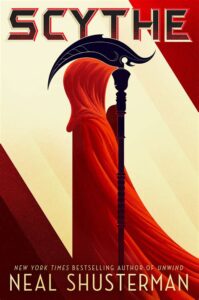
A new wave of dystopian stories have hit pop culture and YA literature in the past decade. It would appear that young adults are fascinated with tales about vampires, zombies, and other worldly realities that challenge stalwart heroines and heroes to defy the odds, preserve their lives, and promote social justice. Adults are usually the villains in these twisted stories, and young adults are the heroines and heroes. The Giver, The Hunger Games, and The Maze Runner are a few examples of dystopian societies. Psychologists have suggested that these stories symbolize the struggles adolescents face when entering the world of their parents and assuming new responsibilities. They resolve the conflicts through their readings of these books. Others say it’s the exciting settings, characters, and themes they offer – I tend to agree!
Scythe by Neal Shusterman joins the ranks of these YA novels. In this dystopian society, there is no death, illness, war, or hunger – everything has been placed in balance by superior technology. However, there is overpopulation! Consequently, the Scythes have been statistically directed (by technology) to glean the population at regular intervals to insure the efficiency and continuity of the world’s resources and needs. Scythes must be chosen from society. The two protagonists, Citra and Rowan are selected and must be trained in the “art” of taking a life by master scythes. These teenage apprentices face considerable physical and mental challenges as they grasp the scope of their duties and the possible consequences of their inactions. If they do not take lives, their own family members will be killed. The moral dilemma they face reminds me of Jonas in The Giver, and the baby Gabriel he saves from “release.”
The crafting of the novel is interesting, as journal entries are interspersed throughout the chapters to enrich the character description of the master scythes. The book is not an easy read, and can be laborious as you must continually reshift perspectives from these entries to the plot – or “connect the dots.” Therefore, it is not for everyone. Once acclimated to the book’s style of writing, however, the complex relationship between Cira and Rowan is worth the read.
Be aware! There are disturbing and gory images portrayed in descriptions of the scythes’ trials, battles, and gleanings. I would read this book yourself before suggesting it to a young adult you know. In addition, teachers need time to conceptualize ways to present the themes of inhumanity, death, and suicide. For, even though young adults have been desensitized to brutality from video games and pop culture, the violence in this book is so vivid. It creates indelible images in your mind.
Joanne
